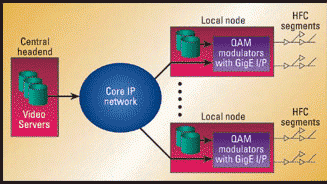MPEG encoding for transmission

The compression of video and audio is extensively used throughout broadcasting in order to achieve efficient use of available transmission bandwidth and storage capacity. A collection of algorithmic techniques are available to the compression designer, and a variety of defined schemes have come into existence, each with certain characteristics suited to the end application.
MPEG refers to a family of specifications for a wide range of compression applications. These applications include PC-based video, mobile devices and high-definition television. The MPEG-2 specification ISO/IEC 13818 defines ‘generic coding of moving pictures and associated audio information’ and is currently the dominant specification in broadcast transmission.
Many of today’s broadcast systems would not have been feasible without MPEG-2, but introducing compression is not wholly advantageous. Characteristics such as error resilience, latency and picture quality, together with wider systems issues such as interoperability, make practical implementation of compressed video services a specialist skill.
MPEG-2 technology
The job of the encoding system is to produce a compressed bit stream that is decodable according to the MPEG-2 specification. System design is such that much of the processing takes place at the encoder, making it possible to produce relatively low-cost decoders for mass deployment. It is then possible to improve the encoding side of the system as technology develops without the need to replace decoders.
In an intra-frame compression system, the quantizer ensures that only the significant frequency components in each block are actually transmitted; hence, compression is achieved. A further valuable improvement is achieved by inter-frame estimation of the movement of blocks between each picture and sending motion vectors to change placement of blocks at the decoder.

Canal+ has a 24-hour domestic news channel that uses 29 satellite news gathering vans, which are entirely journalist operated.
The professional video industry's #1 source for news, trends and product and tech information. Sign up below.
Beyond the video compression stage, multiplexing of audio and associated data for conditional access or service information, for example, takes place to create a transport stream. Then the bit stream must be matched to the transmission channel being used. This could be satellite, terrestrial, cable or copper — each with different characteristics requiring appropriate channel coding and modulation. Transmission specifications have been developed in different regions of the world. Figure 1 highlights the stages in processing for satellite and ATM networks.
Given these specifications, further work is needed to ensure that different components of a compression system interoperate correctly. An approach to solving this problem is the development of implementation guidelines and practical tests of interoperability, such as those carried out by the International Satellite Operating Group and Professional MPEG Forum.
Operational considerations
One area of concern when using aggressive compression such as MPEG on both video and audio is the potentially devastating effects of cascading systems. The final compression delivery to the home is optimized to use minimal capacity and, therefore, the maximum compression that can be tolerated. This approach, however, does not take into account previous significant compression having been applied in production or primary distribution. Techniques have been developed by some encoder manufacturers to allow ‘intelligent’ re-coding, including automatic GOP alignment of a re-encode process as well as more thorough systems that carry forward all the previous key encoding decisions to downstream re-encoders.
Once compression is applied, each bit of data in the transmission represents more information, so any loss of data could have a big impact on the service. During the transport of MPEG data for transmission, forward error correction (FEC) is applied to allow an amount of corrupted or lost data to be recovered. FEC can be applied to each link in a chain to prevent reaching uncorrectable error levels. An additional benefit is the ability to then measure and monitor absolute integrity of the delivery channel.
As more and more transmission applications are unattended, the service management capability of all equipment, including MPEG compression, needs to be of sufficient capability to allow adequate diagnosis of performance. SNMP is now in widespread use for alarm management as well as system configuration, and comprehensive performance management of video services is currently seen as a key differentiator by broadcasters seeking to outsource their transmission requirements.
The future
Recent improvements in MPEG encoding have been seen in terms of encoder cost, physical size, picture quality, latency reduction, power consumption and service management. For example, a recent encoding solution development is a half-rack-width, 1U high encoder that consumes only 20W and features a potential end-to-end latency of only 40ms.
While MPEG-2 is at the stage of relative maturity, developments continue to address new applications such as high-definition encoding. Beyond regular broadcasting services, applications such as digital cinema are receiving much attention, and many organizations now recognize the quality levels achievable with compression as being fully acceptable for distribution to cinemas.
Compression efficiency continues to improve. The MPEG development of advanced video coding in the form of MPEG-4 part 10, for example, has made it possible to halve the bit rates previously required for broadcast distribution. This provides the opportunity to provide broadcast video qualities over alternative delivery channels such as digital subscriber line (DSL) to the home.
Peter Elmer and Andy Rayner work for the Video Communications Engineering Centre, BTexact Technologies, where Peter is portfolio engineering manager for broadcasting, and Andy is group leader for broadcast TV solutions.
